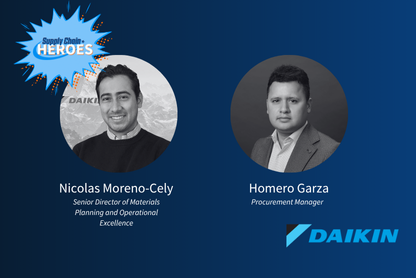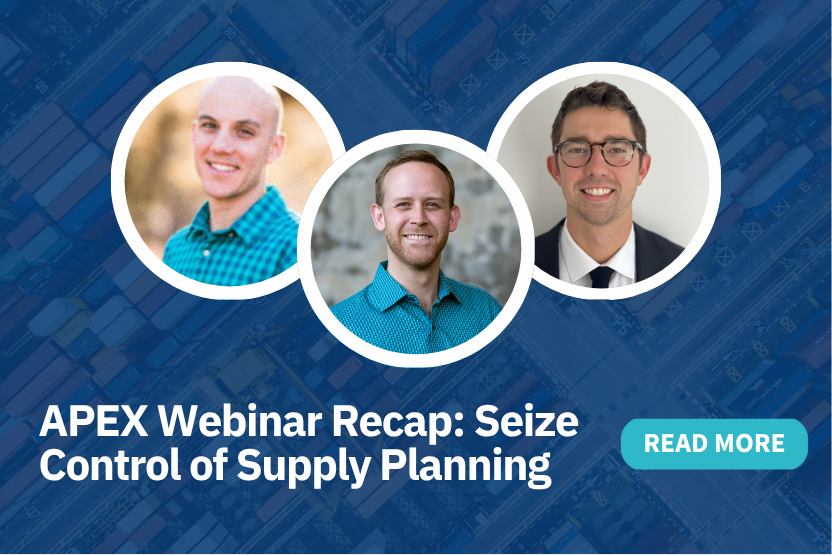Successful supply chain transformation requires practical steps, strong leadership, and tools that empower your team to make data-driven decisions. In our recent webinar, Deniz Balci, Sr. Global Manager, Inventory & Warehouse at AGI, led an insightful discussion on navigating supply chain transformation and empowering your teams through the process.
Here’s a closer look at Deniz’s key advice for creating lasting value in your supply chain:
1. Progress Over Perfection
ERP systems can make it hard to access clean, consistent data. Many manufacturing organizations deal with the challenges of multiple ERP systems and set ups: no standardization and limited cross site visibility, leaving them reliant on static, manual spreadsheet reporting. Completely standardizing your ERP system is a complicated problem to solve, start by focusing on smaller steps to standardize how your team works:
- Aligning daily tasks across buyers, planners, and inventory managers helps reduce noise and improve focus. Instead of trying to fix the ERP, start by organizing the day-to-day. Define what each role should prioritize and create structure through leader standard work.
- Consistent data views are just as important. When everyone sees the same information in the same format, collaboration becomes easier and decisions can be made faster.
- Using tools like LeanDNA help teams prioritize actions, run ABC/XYZ analysis, and cut down time spent digging through data. The goal is to shift focus from chasing information to making decisions.
When navigating transformation, aiming for progress over perfection is what creates momentum. Instead of trying to fix everything at once, start small. Focus on catching data discrepancies, improving data quality, and driving impact in one area at a time. True transformation starts with everyday actions and goals.
“Rome wasn’t built in a day. Start with shortages. Start with what’s in front of you.” - Deniz Balci
2. Optimization Starts With Prioritization
The goal is inventory optimization, but that starts with prioritization. You can’t optimize what you don’t measure. Think of it like grocery shopping. If you don’t know what’s already in your fridge, you might buy too many tomatoes or forget the milk. You would not store a year’s supply of paper towels just because they are on sale. Excess stock ties up space and resources.
“You need to have the right inventory, right quantity, at the right time, for the right price.” - Deniz Balci
Management focuses on day-to-day tasks in your ERP such as ordering, tracking, receiving, and shipping. Optimization goes further. It uses data forecasting and algorithms to look at the whole business and blend multiple factors to find the right balance.
Without a tool analyzing your data and recommending prioritized actions, managing inventory becomes messy. It is just like going grocery shopping without a list. You don’t have visibility into your refrigerator and might miss what you actually need. The key is having a system that does the heavy lifting so you can focus on smart decisions that drive real results.
“Power BI is good, but it's not enough. At the end of the day, you still need to figure out what you should be doing. Tools like LeanDNA analyze the data for you, and provide you with actions.” - Deniz Balci
3. Empower People to Drive Change
At the core of any operational transformation is the team that’s behind it all. Understanding your team's problems means spending time on-site, listening to their major challenges, and bringing them into the solution. To do that well, you have to be present. Walk the floor, talk to people, and take the time to understand what’s working and what’s not. Be mindful of the day-to-day challenges your team is facing. Give them a voice, bring them into testing and training, and keep the conversation going with follow-ups. When people feel heard, they’re more likely to buy in. Lead by example by showing up and staying involved. Sit in on the training. Go through the user testing. Be part of the process just like everyone else. When the team sees you working alongside them, it sends a clear message: this change is a team effort, and you’re in it together. The best leaders build champions by starting with the why and celebrating the wins along the way.
Final Takeaways
- Start with the why: Alignment is your foundation
- Focus on small wins: Progress is more powerful than perfection
- Empower your team: People drive transformation
- Measure what matters: “If you can’t measure it, you can’t improve it”
As Deniz highlighted, successful transformation is less about perfection and more about steady, focused progress. By organizing your daily work, applying tools that surface priorities, and proactively leading your team, you create lasting, sustainable improvements in your supply chain.
To hear the full conversation watch the webinar on-demand.






